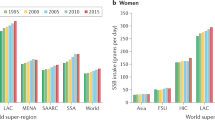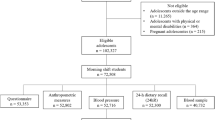Abstract
Background/Objectives:
Excessive consumption of sugar-sweetened beverages (SSBs) increases risk of obesity. Similar data are lacking in Chinese populations with rapid nutritional transition. We aimed to examine the association between SSB intake, lifestyle factors and obesity in Hong Kong Chinese.
Subjects/Methods:
This is a cross-sectional survey on SSB intake with 2295 (49.6%) men and 2334 (50.4%) women (age: median 43.0 years, range 18–81 years). They were recruited from a territory-wide health promotion campaign in Hong Kong. All subjects completed a questionnaire and underwent simple health tests. Their SSB intake was based on a 1-week recall (1 unit of SSB=250 ml, frequent SSB consumption=daily intake⩾2 units).
Results:
Men were more likely than women to smoke, drink alcohol, frequently consumed SSB (20.5 vs 9.5%) and ate more meat portions (2.32±0.57 vs 2.15±0.44) but were physically more active (no exercise: 31.2 vs 39.2%) (P-values: all <0.001). After adjusting for confounding factors, frequent SSB intake remained independently associated with obesity in women (odds ratio (95% confidence interval): 1.86 (1.36–2.55)) while physical inactivity (1.84 (1.41–2.39) for none vs regular), smoking (1.29 (1.05–1.58)) and high daily meat intake (2.15 (1.36, 3.42)) predicted obesity in men.
Conclusions:
In Chinese of working age, SSB consumption in women and physical inactivity, smoking and high meat intake in men were associated with obesity.
This is a preview of subscription content, access via your institution
Access options
Subscribe to this journal
Receive 12 print issues and online access
$259.00 per year
only $21.58 per issue
Buy this article
- Purchase on Springer Link
- Instant access to full article PDF
Prices may be subject to local taxes which are calculated during checkout
Similar content being viewed by others
References
Ariza AJ, Chen EH, Binns HJ, Christoffel KK (2004). Risk factors for overweight in five- to six-year-old Hispanic-American children: a pilot study. J Urban Health 81, 150–161.
Bachman CM, Baranowski T, Nicklas TA (2006). Is there an association between sweetened beverages and adiposity? Nutr Rev 64, 153–174.
Bawa S (2005). The role of the consumption of beverages in the obesity epidemic. J R Soc Promot Health 125, 124–128.
Berkey CS, Rockett HR, Field AE, Gillman MW, Colditz GA (2004). Sugar-added beverages and adolescent weight change. Obes Res 12, 778–788.
Bes-Rastrollo M, Sanchez-Villegas A, Gomez-Gracia E, Martinez JA, Pajares RM, Martinez-Gonzalez MA (2006). Predictors of weight gain in a Mediterranean cohort: the Seguimiento Universidad de Navarra Study 1. Am J Clin Nutr 83, 362–370;quiz 394-365.
Bleich SN, Wang YC, Wang Y, Gortmaker SL (2009). Increasing consumption of sugar-sweetened beverages among US adults: 1988-1994 to 1999-2004. Am J Clin Nutr 89, 372–381.
Blum JW, Jacobsen DJ, Donnelly JE (2005). Beverage consumption patterns in elementary school aged children across a two-year period. J Am Coll Nutr 24, 93–98.
CDC (2003). Centers for Disease Control (CDC), National Center for Chronic Disease Prevention and Health Promotion. Physical activity and good nutrition: essential elements to prevent chronic diseases and obesity 2003. Nutr Clin Care 6, 135–138.
Chan JC, Malik V, Jia W, Kadowaki T, Yajnik CS, Yoon KH et al. (2009). Diabetes in Asia: epidemiology, risk factors, and pathophysiology. JAMA 301, 2129–2140.
Chen CC, Li TC, Chang PC, Liu CS, Lin WY, Wu MT et al. (2008). Association among cigarette smoking, metabolic syndrome, and its individual components: the metabolic syndrome study in Taiwan. Metabolism 57, 544–548.
Chen L, Appel LJ, Loria C, Lin PH, Champagne CM, Elmer PJ et al. (2009). Reduction in consumption of sugar-sweetened beverages is associated with weight loss: the PREMIER trial. Am J Clin Nutr 89, 1299–1306.
Cho NH, Chan JC, Jang HC, Lim S, Kim HL, Choi SH (2009). Cigarette smoking is an independent risk factor for type 2 diabetes: a four-year community-based prospective study. Clin Endocrinol (Oxf) 71, 679–685.
Drewnowski A, Bellisle F (2007). Liquid calories, sugar, and body weight. Am J Clin Nutr 85, 651–661.
Hui SC, Morrow JC, Leung WC (1999). Comparison of the physical activity levels between American adults and Hong Kong Chinese adults. Med Sci Sports Exerc 31 (Suppl), S165.
Ko GT, Chan JC, Chan AW, Wong PT, Hui SS, Tong SD et al. (2007). Association between sleeping hours, working hours and obesity in Hong Kong Chinese: the ‘better health for better Hong Kong’ health promotion campaign. Int J Obes (Lond) 31, 254–260.
Ko GT, Chan JC, Tsang LW, Critchley JA, Cockram CS (2001). Smoking and diabetes in Chinese men. Postgrad Med J 77, 240–243.
Kvaavik E, Andersen LF, Klepp KI (2005). The stability of soft drinks intake from adolescence to adult age and the association between long-term consumption of soft drinks and lifestyle factors and body weight. Public Health Nutr 8, 149–157.
Malik VS, Schulze MB, Hu FB (2006). Intake of sugar-sweetened beverages and weight gain: a systematic review. Am J Clin Nutr 84, 274–288.
Misra A, Khurana L (2008). Obesity and the metabolic syndrome in developing countries. J Clin Endocrinol Metab 93, S9–30.
Murakami K, Sasaki S, Takahashi Y, Okubo H, Hosoi Y, Horiguchi H et al. (2006). Dietary glycemic index and load in relation to metabolic risk factors in Japanese female farmers with traditional dietary habits. Am J Clin Nutr 83, 1161–1169.
Nielsen SJ, Popkin BM (2004). Changes in beverage intake between 1977 and 2001. Am J Prev Med 27, 205–210.
Olsen NJ, Heitmann BL (2009). Intake of calorically sweetened beverages and obesity. Obes Rev 10, 68–75.
Phillips SM, Bandini LG, Naumova EN, Cyr H, Colclough S, Dietz WH et al. (2004). Energy-dense snack food intake in adolescence: longitudinal relationship to weight and fatness. Obes Res 12, 461–472.
Popkin BM, Nielsen SJ (2003). The sweetening of the world's diet. Obes Res 11, 1325–1332.
Schulze MB, Manson JE, Ludwig DS, Colditz GA, Stampfer MJ, Willett WC et al. (2004). Sugar-sweetened beverages, weight gain, and incidence of type 2 diabetes in young and middle-aged women. JAMA 292, 927–934.
Villegas R, Liu S, Gao YT, Yang G, Li H, Zheng W et al. (2007). Prospective study of dietary carbohydrates, glycemic index, glycemic load, and incidence of type 2 diabetes mellitus in middle-aged Chinese women. Arch Intern Med 167, 2310–2316.
Wadden TA, West DS, Neiberg RH, Wing RR, Ryan DH, Johnson KC et al. (2009). One-year weight losses in the Look AHEAD study: factors associated with success. Obesity (Silver Spring) 17, 713–722.
Welsh JA, Cogswell ME, Rogers S, Rockett H, Mei Z, Grummer-Strawn LM (2005). Overweight among low-income preschool children associated with the consumption of sweet drinks: Missouri, 1999–2002. Pediatrics 115, e223–e229.
WHO (2004). World Health Organization (WHO) Expert Consultation: appropriate body-mass index for Asian populations and its implications for policy and intervention strategies. Lancet 363, 157–163.
Wu Y (2006). Overweight and obesity in China. Br Med J 333, 362–363.
Wu Y, Zhou B, Tao S, Wu X, Yang J, Li Y et al. (2002). Prevalence of overweight and obesity in Chinese middle-aged populations: current status and trend of development. Zhonghua Liu Xing Bing Xue Za Zhi 23, 11–15.
Zhou BF (2002). Predictive values of body mass index and waist circumference for risk factors of certain related diseases in Chinese adults--study on optimal cut-off points of body mass index and waist circumference in Chinese adults. Biomed Environ Sci 15, 83–96.
Acknowledgements
We thank all participating labor unions and their members in making this study possible. The study was funded by the Hong Kong Hospital Authority with partial support from the Li Ka Shing Foundation. Members of the Research Committee of the BHBHK Campaign include Professor Cecilia LW Chan, Professor Juliana CN Chan, Dr Gary TC Ko, Professor Stanley SC Hui, Professor CY Chiu, Rosalie SY Kwong, Selina Khor, CY Wong, Spencer DY Tong, Amy WY Chan, Ruby LP Kwok, Ferrie Chow and Patrick TS Wong.
Author information
Authors and Affiliations
Consortia
Corresponding author
Ethics declarations
Competing interests
The authors declare no conflict of interest.
Rights and permissions
About this article
Cite this article
Ko, G., So, Wy., Chow, Cc. et al. Risk associations of obesity with sugar-sweetened beverages and lifestyle factors in Chinese: the ‘Better Health for Better Hong Kong’ health promotion campaign. Eur J Clin Nutr 64, 1386–1392 (2010). https://doi.org/10.1038/ejcn.2010.181
Received:
Revised:
Accepted:
Published:
Issue Date:
DOI: https://doi.org/10.1038/ejcn.2010.181
Keywords
This article is cited by
-
Intakes of major food groups in China and UK: results from 100,000 adults in the China Kadoorie biobank and UK biobank
European Journal of Nutrition (2022)
-
Etiology of Obesity Over the Life Span: Ecological and Genetic Highlights from Asian Countries
Current Obesity Reports (2014)
-
Global obesity: trends, risk factors and policy implications
Nature Reviews Endocrinology (2013)
-
Epidemiology of general obesity, abdominal obesity and related risk factors in urban adults from 33 communities of northeast china: the CHPSNE study
BMC Public Health (2012)
-
Demographic, socioeconomic and nutritional determinants of daily versus non-daily sugar-sweetened and artificially sweetened beverage consumption
European Journal of Clinical Nutrition (2012)



